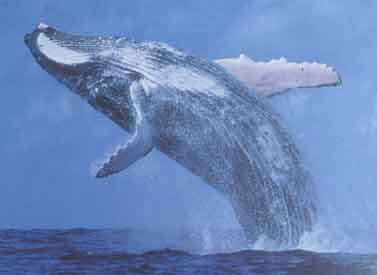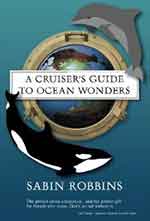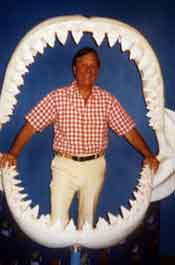CRUISE SHIP LECTURES :
The Secret Life of Whales
Author-naturalist, Sabin Robbins talks about the secret life of whales in these notes from his book : A Cruiser's Guide to Ocean Wonders
THE SECRET LIFE OF WHALES

They move through a vast, dim, dark, watery world of their own. They are timeless and ancient, part of our common heritage and yet remote. They roam the ocean floor half-a-mile down, under the guidance of powers and senses we hardly understand. For we who rule the land, still know little of those that rule the deep. Their behavior still mystifies us. Their intricate sounds puzzle us. Their movements remain largely unknown. Their elaborate brains remain a riddle as do their lifestyles and relationships with each other. In every ocean, they swim and sing and socialize and travel as far as the sea is wide.
Like us on land, we know, however, that they are warm-blooded, must breathe to live, and just like us, give birth to babies that nurse on breast milk. They are our kindred spirits in the sea. They are the largest creatures ever to live on earth. They are, of course, the whales.
The story of man and whales goes back to the beginning of man. And our relationship with them is full of contradictions for we have feared and revered them, slaughtered and saved them.
Click here to buy a copy of A Cruiser’s Guide to Ocean Mysteries
Once called the "Leviathan" and "the great fish," they were feared as in the Bible's story of Jonah and the Whale. Because so little was known about them, it's not surprising that they were wrapped in mystery—and feared. When people first saw dead whales washed up on their beach that were 80-feet long and weighed 100 tons, they called them "demons of the deep." Early experts were sure that whales ate boats, and their bad breath caused brain damage.
Unfortunately, the theme of man's fear was soon followed by centuries of exploitation as killing whales made people rich because of the meat, oil, and other valuable parts. Rock carvings indicate men hunted whales with boats and harpoons 4,000 years ago. Europeans and Japanese were heavily involved in killing and processing whales 1,000 years ago.
Huge profits drove the industry. There was whale oil that lit the lamps of the world before electricity and lubricated the wheels of industry. The thin, flexible strips of whalebone made wonderful corset stays, hoops for skirts, umbrella ribs, buggy whips, clock springs, and fishing rods. They were even used as whips to discipline schoolchildren. Thus the child got "a whaling."
There was whale blubber used to make everything from soap and paint to margarine and dynamite. Ivory teeth were carved into buttons, necklaces, piano keys, and art objects. Whale skin was tanned for leather. Their skulls made farm walls, their flippers made glue, their tendons made tennis racquet strings, and their bones, blood, and guts were turned into pet food and fertilizer. Nothing was wasted—except the whale itself!
But if whales lost out by the millions, there was always danger for the whaler as well. Imagine being in a small, fragile boat in the middle of an icy, remote sea, and harpooning something 1,000 times heavier and stronger than you. A young Arthur Conan Doyle, creator of Sherlock Holmes, fell out of his whaleboat so often he was nicknamed "the Great Northern Diver."
On rare occasions, an enraged whale would attack the whaler. The most famous rogue whale was Mocha Dick, a 70-foot sperm whale that would be the model for Melville's Moby-Dick. For 30 years this giant battled the whalers that tried to kill him. When Mocha Dick was finally killed in 1859, they found 20 harpoons in his scarred hide from more than 100 battles in which at least 30 men had been killed and dozens of whaleboats destroyed.
By the mid-19th-century, 700 American whaling ships and 70,000 people were killing and processing whales. As Melville wrote, "The wealth of New England was harpooned and dragged up from the bottom of the sea."
It was a Norwegian whaling captain, Svend Foyn, who would lower the danger and increase the yield by building the first steam-powered and therefore speedy whale catcher. And he followed it up by inventing a cannon-fired harpoon that had a bomb in its tip. Later would come world-roaming factory ships and ship-based helicopters used as spotters. No whale anywhere in the world had a chance now. The pattern of killing was simple—hunt and kill the closest and easiest species until you can't find it anymore, then move on to the next species, and so on.
Whales were not just being used, they were being used up. Nearly two million whales were killed in just the 50 years prior to 1970. Even today in Japan, Norway, and Iceland, whale meat is sold in markets and served up in restaurants.
Too often, whales suffered long, agonizing deaths by harpoons. As one ex-whaler told me, "If whales could scream, whaling would have stopped years ago."
But popular opinion started turning in the '60s and '70s, especially in America, perhaps because so many whales can be seen along its shores. It began with Flipper and the performances of trained dolphins that caught the public interest, respect, and love for marine mammals. Books and television specials highlighted their fascinating behavior. The love affair with whales caught fire. Now it was whale lovers against whale killers as Greenpeace protesters put themselves between the harpoon cannons and the whales.
At the same time, millions watched whales from shores and boats making whale-watching a bigger business than whale-killing. Finally, the thousand-year-old war on whales is coming to an end. And happily, most whales are coming back in increasing numbers. In contrast to the past, we think about whales with equal parts of awe, wonder, reverence, and yes, guilt. These gentle giants have become an exalted, larger than life symbol of the environmental movement. And we humans have turned from predator to protector.
If the story of humans and whales goes back a long time, the story of just the whale goes back a lot longer. Like other warm- blooded, air-breathing marine mammals like seals and sea lions, whales began as land-living mammals. Then 60 million years ago, they started to live in water. No one knows why. Perhaps there was more food in the water, or rising water forced them off the land.
DNA evidence indicates that the likely ancestor of whales was a relative of the hippo, whose legs evolved over millions of years into tail and flippers. Since whales are the marine mammals that have lived the longest in water, they are more fish-like than sea lions or seals. Yet they still carry reminders of their land ancestors. Their flippers have buried within them the bones of five fingers just like our hands. Very occasionally, whales have half-formed hind legs protruding from the rear of their bodies in a kind of genetic throw-back to the days when they had legs and walked on land.
All but a dozen of the some 80 species of whales have teeth and that includes all the dolphins and porpoises considered whales in all but size. Thanks to their teeth, scientists can estimate how old they are because their teeth have growth rings just like a tree.
Instead of teeth, a dozen species have baleen, a series of comb-like plates called whalebone that are flexible and fringed like a mop. Baleen is made of keratin, the same substance as our fingernails, and serves as a sieve to catch and filter the tiny fish and plankton they feed on.
Many whales have blotched skin because, like ships, they seem to attract lots of barnacles as well as crab-like lice.
All whales spout or breathe through their noses that evolutionarily have moved to the top of their heads to make breathing easier in the water. Experts can tell each species by the height and pattern of the blow since each species has differently-shaped nostrils.
The spout is not exhaled water. It's the warm, moist air exhaled from the whale's lungs that cools and condenses into moisture, like your breath does on a cold day. Having spent a lot of time with whales, I can tell you that their fish diet makes for some awful smelling breath close-up!
A whale's social life varies considerably. Some tend to be loners; others travel in groups called pods. Courtship often includes an increase in breaching or leaping out of the water. Courting can also include lobtailing or raising the tail above the water and then bringing it down with a mighty slap. Some whales will also check out what's going on by spy hopping or raising their head above the water.
Pregnancy is about a year. Newborns are generally born tail first. They are fully functional at birth, though will nurse for a year or more. Whale milk has the texture of canned milk but is ten times richer than cow's milk. It has a nutty not fishy taste so would be perfect on your strawberries at breakfast!
Calves will take piggyback rides on their moms. They reach maturity at six to 13 years, and, depending on the species, live 30 to possibly 200 years.
One of the most puzzling of all whale behaviors is their occasional determination to beach themselves and die either in shallow water or on the beach. And when people push them back out to safety, they return to the beach and sure death. In Argentina, 835 whales stranded and died at one time in 1946. Some years later, more than 1,000 whales at one time stranded and died along 20 miles of beach on Cape Cod.
Since circumstances and species vary, it's difficult to pinpoint a single cause of stranding. Over the years, many experts have given many explanations. Many scientists believe that the whales have gotten disorientated or lost because of a break-down in their navigation system. But that doesn't explain mass strandings. Some say their brains or inner ears are infested with parasitic worms that confuse their navigation. But the same worms are found in non-stranded whales. Some blame the super-powerful sonar used on Navy ships to detect enemy submarines, but many whales strand where there are no Navy ships.
Then there are the less persuasive theories. Earthquakes or storms trigger panic. It's the phases of the moon. Or a painful migraine headache causes the whale to throw itself onto the beach. And finally, whales are committing suicide to protest the whaling industry!
What may be truest of all is that we are no closer to solving the mystery than we were 2,000 years ago when Aristotle wrote, "It is not known why whales run themselves onto dry land. They seem placidly bent on self-destruction."
Humpback whales (Megaptera novaeangliae/"Big-winged New Englander"), once 100,000 strong, were so successfully harpooned to make lubricants, detergents, and even lipstick and shoe polish, that they may only number 30,000 today. Fortunately, they are coming back under protection.
They can reach 50 feet and got their name because they expose a large part of their back that looks hump-like when they dive.
If you're bothered by ants at a picnic, pity the poor humpback that carries 1,000 pounds of barnacles on its body plus inch-long lice that infest its skin.
As the most acrobatic of all large whales, a humpback will often leap completely out of the water—and do it many times in a row. This is amazing as they can weigh 40 tons. When I was in Alaska a few years ago, a seaplane taking off was almost knocked out of the air by a high-jumping humpback. No one knows why they do it. Exuberance? A show of strength? To dislodge all those lice and parasites? Or perhaps it's part of the mating as they do it more during courtship.
The long front flippers that can extend a third of their body are unique to humpbacks, and gave them their Latin name meaning "Big-winged New Englander." Because of those long flippers, humpbacks are the only whales known to swim backwards.
Humpbacks have devised two unique feeding techniques. Lunging through schools of fish, they'll stun them with a slap of their flippers or tail, then gulp the fish down.
More remarkable, humpbacks make their own fish nets using bubbles. They begin by swimming beneath a school of fish, and blow out air to create a "net" of bubbles that surrounds the fish. Then with mouth open, they swim up for a quick meal. They even make different-size bubbles for different-size fish!
Of all the wondrous things humpbacks do, the most amazing is their singing ability. No other species makes more diverse sounds—clicks, grunts, groans, and whistles. Only the males sing, and mostly in their mating areas, so it seems to be part of their courtship. Observers say that the males that sing the best songs get the most girls so they call these whales "Engelbert Humperbacks." Their singing is so remarkable that when the space capsule, Voyager IV, rocketed beyond our solar system, it carried a greeting intended to convey the essence of earth cultures that included 60 human languages—and a humpback song.
Whale expert Roger Payne, who recorded a best-selling album called "Songs of the Humpback Whales," said that all the whales in a given group sing pretty much the same song, and then amazingly change that song every year. The whales don't just sing mechanically. They compose as they go along, incorporating new elements into their old songs. And the songs from one year to the next can be as different as Beethoven from the Beatles. No other animal except man does this, so it remains one of nature's great mysteries.
As author Peter Matthiessen wrote, "No word conveys the eeriness of the whale song, tuned by the ages to a purity beyond refining. It is a sound we should hear each morning to remind us of the dawn of the world."
California gray whales (Eschrichtius robustus) make the longest annual migration of any mammal on the planet—8,000 miles from Mexico to Alaska and back. That's like swimming to the moon and back over a lifetime.
They mate, give birth, and nurse their young during winter months in the lagoons of Baja California. By late-spring, the 20- foot-long babies join their 40-foot moms in pods up the Pacific coast to the fish-rich waters of the Arctic where they gorge on plankton, crabs, and shrimp before returning to Baja in late fall. They can average 60 miles a day.
Like humans, gray whales are right-handed or left-handed. A "right-hander" prefers to feed by scooping up food along the bottom using the right-side of its baleen. So that side is more worn down and scarred than the left-side.
California grays were called "Devilfish" by harpooners because they fiercely defended themselves and their young. But they were no match for harpooners who reduced a population of 25,000 to less than 100 by the late 1930s. One of the earliest Americans to fight for their survival was a well-known lover of women as well as whales. It was movie star Errol Flynn who financed the first-ever aerial photo survey that led to protection that has rebounded their population to a healthy 20,000.
Sperm whales (Physeter catodon), thanks to Melville's Moby-Dick, have become the symbol for all whaling. Their 60-foot length and 50-ton weight make them the largest of all toothed whales, and therefore the largest, large-prey predators that have ever lived. Larger than even Tyrannosaurus rex.
Long before Melville's Moby-Dick, sperm whales were hunted around the world because their huge, bulbous heads held up to 1,000 gallons of a fine, clear oil used in luxury candles and creams.
Sperm whale oil is even crucial in space age technology since it is the only known substance that works as a lubricant in the extreme cold temperatures of outer space. Said one scientist, “the Hubble space telescope is wheeling around the earth on spermaceti seeing six billion years into the past.”
Sperm whales got their name because early whalers thought the oil in their heads was the whales' sperm. Admittedly, the head is an unusual location for sperm!
Even more valuable and something only sperm whales have is a waxy substance they secrete in their intestines called ambergris. It was highly sought after in perfume-making because of its astounding power to hold or "fix" the delicate scents in luxury perfumes. A 920-pound lump washed up in Australia in 1953 and sold for $320,000.
It's been said that ambergris was rubbed by Stradivari on his violins, and that was the secret ingredient that produced the violins remarkable sounds.
Herman Melville, by depicting his great white whale as an angry ghost of terror and destruction, demonized whales as effectively as others had demonized sharks and wolves. But Melville was just reflecting sailors' belief that sperm whales were killers bent on destroying men and ships. Although sperm whales never came close to living up to their evil reputation, Melville didn't write total fiction .


